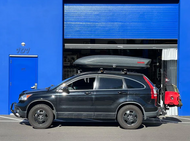Comfort vs Overload Springs
Aug 30th 2024
Comfort vs. Overload Spring Rates: Which Do You Need?
Choosing between comfort and overload spring rates is one of the most common questions we get from customers. On the surface it might seem straightforward, but the decision comes down to how weight is distributed on your vehicle and whether that weight is permanent or temporary. Let’s take a deeper dive.
Comfort Spring Rates: Matching OEM Balance
Comfort springs are engineered to stay within ~5% of your factory spring rates. This means:
-
Your towing capacity and cargo rating remain unchanged.
-
The vehicle maintains OEM ride characteristics, with slightly more control due to our coilover design.
-
You get enough support for everyday use, including common overland setups.
Real-World Example
Let’s say you add:
-
A roof-top tent (weight distributed across all four corners).
-
200–300 lbs of cargo in the back (heavier items packed closer to the rear seats, lighter items near the hatch).
On a comfort spring, that load results in about 0.5–0.75 inches of sag. That level of compression is perfectly normal and well within the suspension’s operating range.
And here’s the key: cargo is temporary. You don’t build your spring rates around something you take in and out of the car. If you need to recover lost ride height for ground clearance on rough terrain, that’s what adjustable coilovers are for — simply raise the spring perch slightly. You’ll regain clearance while keeping a compliant, comfortable ride.
Overload Spring Rates: For Permanent, Static Weight
Overload springs are a much stiffer option, and for most drivers they aren’t necessary. They are designed for situations where the rear suspension is carrying permanent or semi-permanent weight that cannot be offset by occasional preload adjustments.
Common Use Case: Rear Tire Carrier
A swing-out tire carrier is one of the most frequent reasons to step up to overload springs. Unlike cargo that you can unload, a tire carrier is a constant load placed at the very back of the vehicle, which has a large leverage effect on the suspension.
Towing Considerations
Towing is another gray area. Most small trailers in the crossover/SUV segment add about 400 lbs of tongue weight. That weight isn’t carried evenly by the vehicle — it splits primarily across the two rear corners, so each rear spring “feels” about 200 lbs of additional load.
Here’s where things get tricky: you don’t just add 200 lbs of spring rate per corner. Spring rate tuning is about more than just static weight — it’s about keeping suspension travel usable while maintaining ride quality. In many towing cases, a custom spring rate is a better solution than a full overload spring.
When to Consider Custom Rates
Some customers are in between — comfort feels too soft under load, but overload is unnecessarily harsh when unladen. In these situations, we’ll often build a custom spring rate that bridges the gap.
For example:
-
A vehicle that occasionally tows but doesn’t have a permanent tire carrier.
-
A rig with consistent cargo (like tools or equipment) that isn’t as heavy as a tire swing-out but heavier than a weekend camping load.
By splitting the difference, we maintain everyday drivability without compromising support when loaded.
Making the Choice
If we boil it down to the essentials:
-
Comfort springs are right for most builds.
-
Overload springs are justified only when you’ve added permanent weight to the rear of the vehicle (such as a tire carrier).
-
Custom springs are best for those who live in the gray area between the two.
Or, as a simple decision tree:
-
Do you have a hitch-mounted tire carrier or permanent heavy accessory?
-
Yes → Overload springs
-
No → Comfort springs
-
Final Thoughts
Suspension tuning is a balance between comfort, capability, and physics. For most owners, comfort rates provide more than enough support, even with roof-top tents and moderate cargo. Overload springs are a specialized tool for specialized situations. And if you’re not sure where you fall, we’re always happy to discuss your setup and recommend a custom solution.
At Flatout, every suspension kit is designed to maximize usable travel and adjustability, so whether you’re carrying gear, towing, or running light, you’ll always have a solution that matches your real-world needs.



